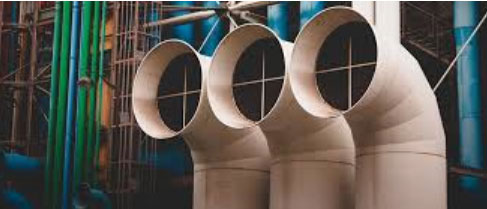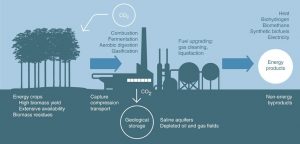What is Direct Air Capture (DAC)?
Most researchers now agree that the daunting math of climate change means we’ll need carbon capture. Models that show us hitting the Paris climate target of “well below” 2°C rise in global average temperature almost all involve enormous amounts of negative emissions, which they mostly get from BECCS. There is urgent need for this technology.
Direct air capture (DAC) is a capture method of carbon capture and storage that separates carbon dioxide from air. While still in the early stages, proponents of direct air capture argue that it is an essential component of climate change mitigation.
Business Opportunities and DAC
Direct Air Capture technologies are grabbing the attention of businesses everywhere. “Some entrepreneurs seem able to conjure money out of thin air. Well now a couple of them have found a way to literally do just that. Capturing the excess CO2 from our atmosphere will be absolutely critical to our ability to meet the goals of the Paris agreement, but there’ll always be someone who spots an opportunity to make a profit along the way” says David Borlace.
In the following video with David Borlace of Just Have a Think provides a discussion on this matter:
Getting the CO2 for the process from the air rather than from fossil fuel emissions takes synthetic fuels from low-carbon to ultra-low-carbon. (Here’s a 2013 Carbon Engineering white paper: “Direct Air Capture as an Enabler of Ultra-Low Carbon Fuels.”
DAC Technologies in Development
This technology is still in early stages of development. Commercial applications include: enhanced oil recovery, production of carbon-neutral synthetic fuel and plastics, as well as beverage carbonation. When combined with long-term storage of CO2, it can reduce its concentration in global atmosphere, although practicality of this application is often questioned. DAC is not an alternative to traditional, point-source carbon capture and storage (CCS), but can be used to manage emissions from distributed sources, like exhaust fumes from cars.
The idea of using many small dispersed DAC scrubbers—analogically to live plants—to create environmentally significant reduction in CO2 levels, has earned the technology a name of artificial trees in popular literature. The other potential negative emissions technology (NET) is DAC + carbon sequestration, which can move carbon from the air (the biosphere) into the ground (the geosphere).
Trees and other green plants pull carbon dioxide out of the air. “Plants have spent billions of years mastering photosynthesis, while we have only a few decades to develop and deploy hundreds of our own carbon-removing plants” says GreenBiz.
Environmental Impacts
Proponents of DAC argue that it is an essential component of climate change mitigation. It can help reach the Paris Climate Agreement goals, although some claim that relying on this technology is risky and might postpone emission reduction under the notion that it will be possible to fix the problem later, and suggest, that reducing emission is, or may be, a better solution. But humans, as a global species are not reducing but rather, increasing emissions.
In the following video, Chemistry Shorts discusses the predicament we find ourselves in further stating that “global climate change is one of the most important challenges of our time, and chemists and chemical engineers are at the forefront of this effort.” In short, at this moment, without DAC technologies, we are headed for trouble.
DAC relying on amine-based absorption demands significant water input. It was estimated, that to capture 3.3 Gigatonnes of CO2 a year would require 300 km3 of water, or 4% of the water used for irrigation. On the other hand, using sodium hydroxide needs far less water, but the substance itself is highly caustic and dangerous.
DAC also requires much greater energy input in comparison to traditional capture from point sources, like flue gas, due to the low concentration of CO2. The theoretical minimum energy required to extract CO2 from ambient air is about 250 kWh per tonne of CO2, while capture from natural gas and coal power plants requires respectively about 100 and 65 kWh per tonne of CO2. Because of this implied demand for energy, some geoengineering promoters have proposed to use “small nuclear power plants” connected to DAC installations, potentially introducing a whole new set of environmental impacts.
When DAC is combined with a carbon capture and storage (CCS) system, it can produce a negative emissions plant, but it would require a carbon-free electricity source. The use of any fossil-fuel-generated electricity would end up releasing more CO2 to the atmosphere than it would capture. Moreover, using DAC for enhanced oil recovery or synthetic fuel production would cancel any supposed climate mitigation benefits.
Costs
According to CleanTechnica, “depending on financial assumptions, energy costs, and the specific choice of inputs and outputs, the levelized cost per ton CO2 captured from the atmosphere ranges from $94 to $232 per ton of carbon dioxide. Let’s not get carried away here. Even at $94 a ton, the cost of carbon capture will be staggeringly high.“
Can Removing Carbon Save Us From Climate Catastrophe?
“Carbon dioxide removal alone cannot do it,” said Kate Gordon, a fellow at the Columbia Center on Global Energy Policy. “If there’s one thing the IPCC report really underscores is that we need a portfolio—we need to reduce emissions dramatically, we need to come up with more renewable energy options to replace fossil fuels, we need to electrify a lot of things that are currently run on petroleum and then we need to do an enormous amount of carbon removal.” In the near term she would like to see more deployment and ramping up of tried and true strategies, such as tree planting trees and more sustainable agricultural practices.
Learn more:
- DAC | National Geographic
- Capture CO2
- Carbon Capture and Storage Association (CCSA)
- Energy Puzzle | VOX
- Faradaic Electro-Swing Reactive Absorption for CO2 Capture | MIT
References:
- Tytie.com (2018). DAC costs less than 100 per ton... Retrieved from https://tytie.com/carbon-engineering-claims-direct-air-capture-of-carbon-costs-less-than-100-per-ton/https://www.current-news.co.uk/news/naomi-klein-renewable-energy-is-ready
- GreenBiz.com (2019). Case for investing in DAC just got clearer. Retrieved from https://www.greenbiz.com/article/case-investing-direct-air-capture-just-got-clearer





